Contemporary Approaches to Health & Wellbeing: NHS Policy and Nurse
VerifiedAdded on 2023/04/24
|12
|3793
|365
Essay
AI Summary
This essay explores contemporary approaches to health and wellbeing, focusing on the increasing life expectancy of older adults and its implications. It begins with an overview of global and UK statistics on life expectancy, followed by a discussion of the challenges associated with an aging population and the importance of healthy aging. The essay then delves into NHS policies and reforms aimed at promoting the health and wellbeing of older adults, highlighting key health determinants and the crucial role of nurses in improving their quality of life. It also touches upon the historical context of healthcare in the UK, from the Poor Law to the establishment of the NHS, and emphasizes the significance of integrated person-centered healthcare delivery systems in addressing the evolving healthcare needs of the population.
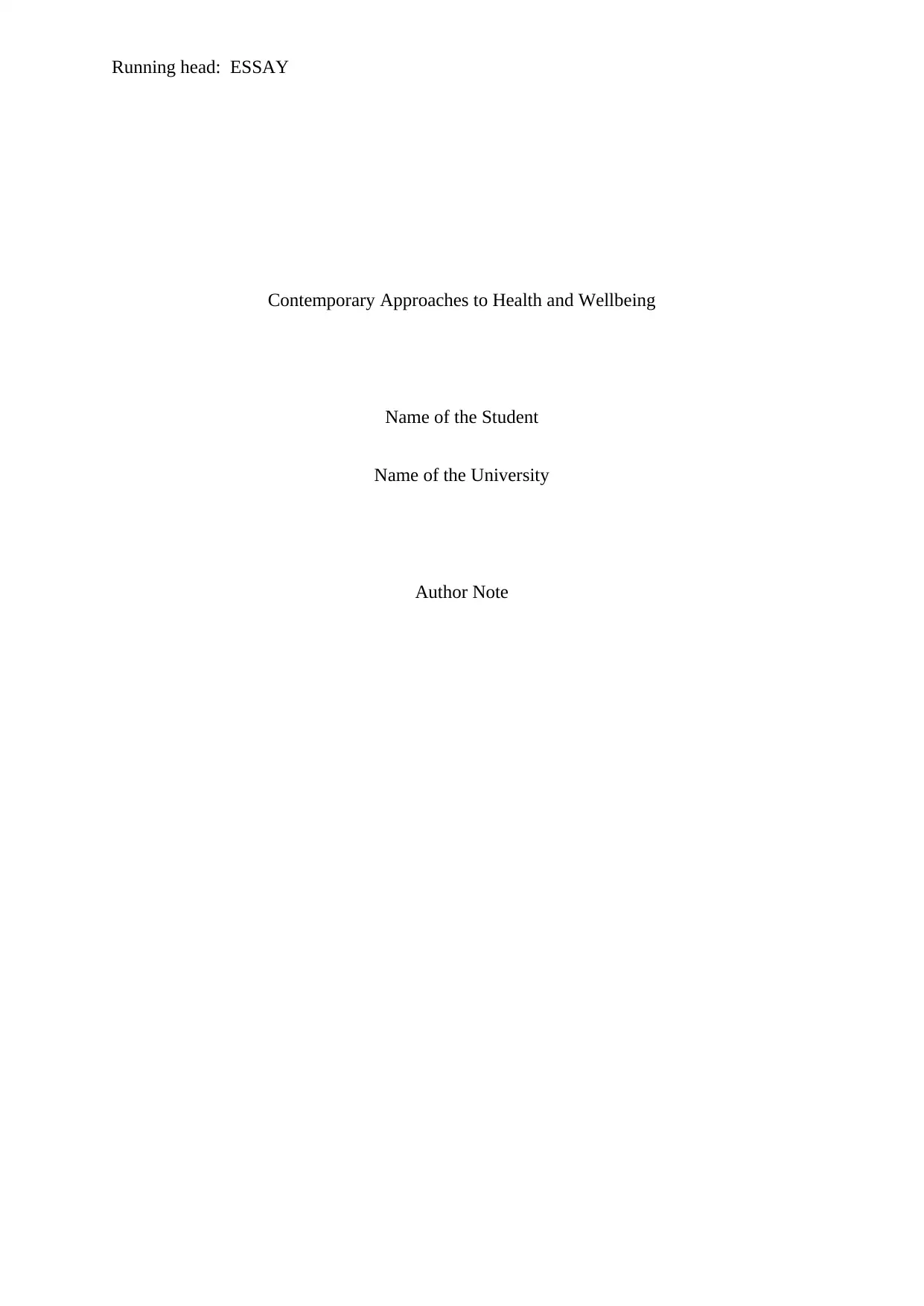
Running head: ESSAY
Contemporary Approaches to Health and Wellbeing
Name of the Student
Name of the University
Author Note
Contemporary Approaches to Health and Wellbeing
Name of the Student
Name of the University
Author Note
Paraphrase This Document
Need a fresh take? Get an instant paraphrase of this document with our AI Paraphraser
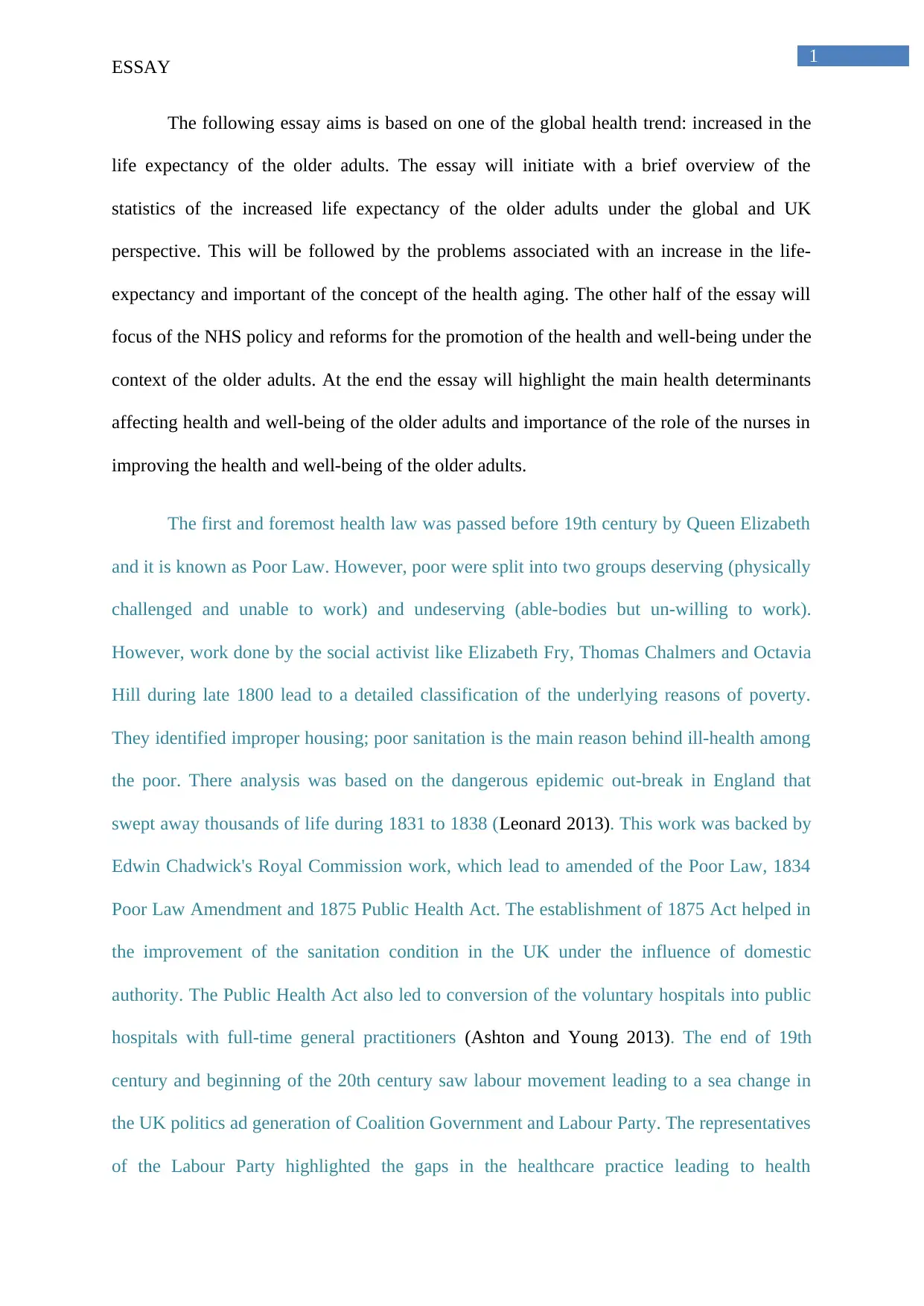
1
ESSAY
The following essay aims is based on one of the global health trend: increased in the
life expectancy of the older adults. The essay will initiate with a brief overview of the
statistics of the increased life expectancy of the older adults under the global and UK
perspective. This will be followed by the problems associated with an increase in the life-
expectancy and important of the concept of the health aging. The other half of the essay will
focus of the NHS policy and reforms for the promotion of the health and well-being under the
context of the older adults. At the end the essay will highlight the main health determinants
affecting health and well-being of the older adults and importance of the role of the nurses in
improving the health and well-being of the older adults.
The first and foremost health law was passed before 19th century by Queen Elizabeth
and it is known as Poor Law. However, poor were split into two groups deserving (physically
challenged and unable to work) and undeserving (able-bodies but un-willing to work).
However, work done by the social activist like Elizabeth Fry, Thomas Chalmers and Octavia
Hill during late 1800 lead to a detailed classification of the underlying reasons of poverty.
They identified improper housing; poor sanitation is the main reason behind ill-health among
the poor. There analysis was based on the dangerous epidemic out-break in England that
swept away thousands of life during 1831 to 1838 (Leonard 2013). This work was backed by
Edwin Chadwick's Royal Commission work, which lead to amended of the Poor Law, 1834
Poor Law Amendment and 1875 Public Health Act. The establishment of 1875 Act helped in
the improvement of the sanitation condition in the UK under the influence of domestic
authority. The Public Health Act also led to conversion of the voluntary hospitals into public
hospitals with full-time general practitioners (Ashton and Young 2013). The end of 19th
century and beginning of the 20th century saw labour movement leading to a sea change in
the UK politics ad generation of Coalition Government and Labour Party. The representatives
of the Labour Party highlighted the gaps in the healthcare practice leading to health
ESSAY
The following essay aims is based on one of the global health trend: increased in the
life expectancy of the older adults. The essay will initiate with a brief overview of the
statistics of the increased life expectancy of the older adults under the global and UK
perspective. This will be followed by the problems associated with an increase in the life-
expectancy and important of the concept of the health aging. The other half of the essay will
focus of the NHS policy and reforms for the promotion of the health and well-being under the
context of the older adults. At the end the essay will highlight the main health determinants
affecting health and well-being of the older adults and importance of the role of the nurses in
improving the health and well-being of the older adults.
The first and foremost health law was passed before 19th century by Queen Elizabeth
and it is known as Poor Law. However, poor were split into two groups deserving (physically
challenged and unable to work) and undeserving (able-bodies but un-willing to work).
However, work done by the social activist like Elizabeth Fry, Thomas Chalmers and Octavia
Hill during late 1800 lead to a detailed classification of the underlying reasons of poverty.
They identified improper housing; poor sanitation is the main reason behind ill-health among
the poor. There analysis was based on the dangerous epidemic out-break in England that
swept away thousands of life during 1831 to 1838 (Leonard 2013). This work was backed by
Edwin Chadwick's Royal Commission work, which lead to amended of the Poor Law, 1834
Poor Law Amendment and 1875 Public Health Act. The establishment of 1875 Act helped in
the improvement of the sanitation condition in the UK under the influence of domestic
authority. The Public Health Act also led to conversion of the voluntary hospitals into public
hospitals with full-time general practitioners (Ashton and Young 2013). The end of 19th
century and beginning of the 20th century saw labour movement leading to a sea change in
the UK politics ad generation of Coalition Government and Labour Party. The representatives
of the Labour Party highlighted the gaps in the healthcare practice leading to health
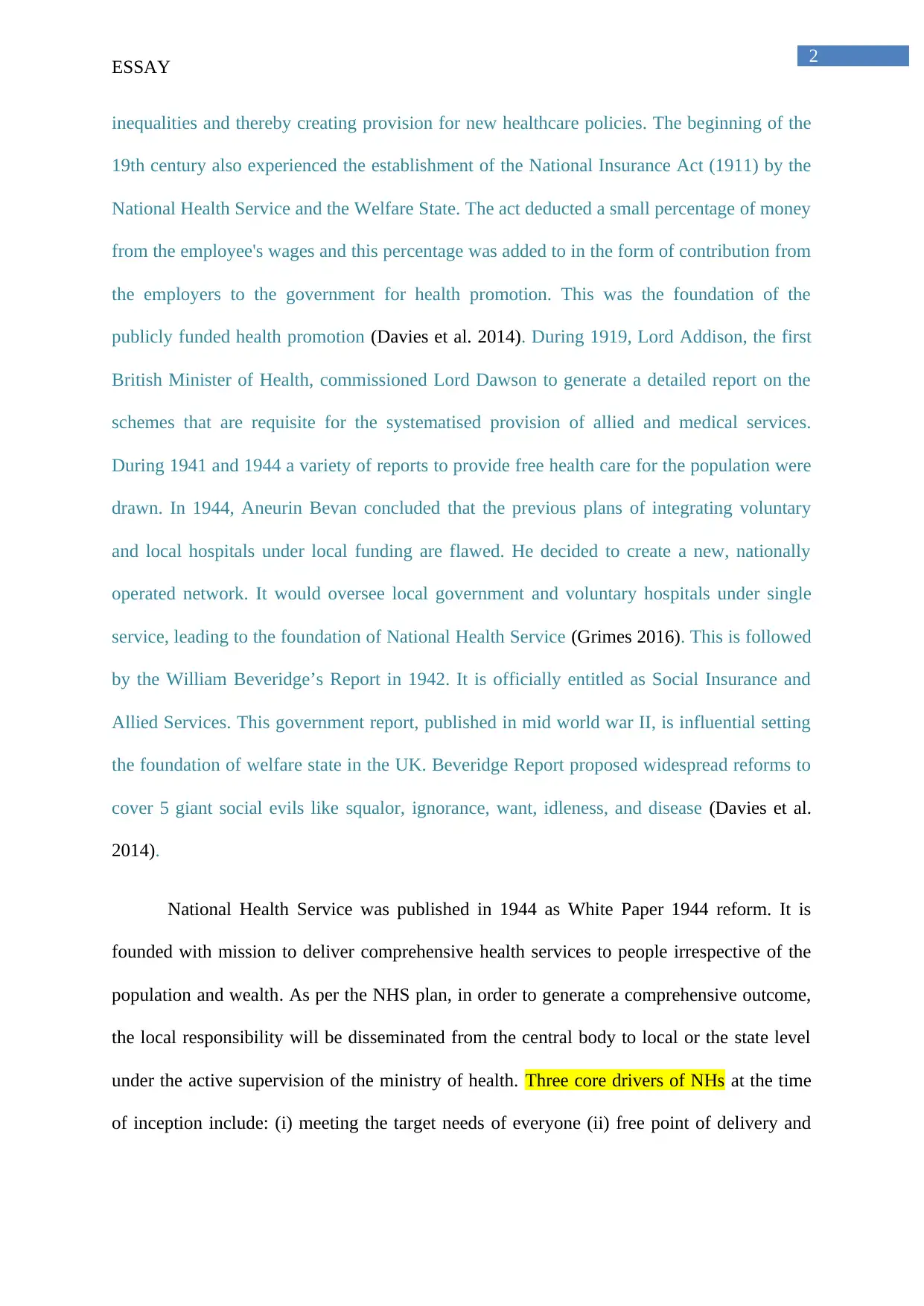
2
ESSAY
inequalities and thereby creating provision for new healthcare policies. The beginning of the
19th century also experienced the establishment of the National Insurance Act (1911) by the
National Health Service and the Welfare State. The act deducted a small percentage of money
from the employee's wages and this percentage was added to in the form of contribution from
the employers to the government for health promotion. This was the foundation of the
publicly funded health promotion (Davies et al. 2014). During 1919, Lord Addison, the first
British Minister of Health, commissioned Lord Dawson to generate a detailed report on the
schemes that are requisite for the systematised provision of allied and medical services.
During 1941 and 1944 a variety of reports to provide free health care for the population were
drawn. In 1944, Aneurin Bevan concluded that the previous plans of integrating voluntary
and local hospitals under local funding are flawed. He decided to create a new, nationally
operated network. It would oversee local government and voluntary hospitals under single
service, leading to the foundation of National Health Service (Grimes 2016). This is followed
by the William Beveridge’s Report in 1942. It is officially entitled as Social Insurance and
Allied Services. This government report, published in mid world war II, is influential setting
the foundation of welfare state in the UK. Beveridge Report proposed widespread reforms to
cover 5 giant social evils like squalor, ignorance, want, idleness, and disease (Davies et al.
2014).
National Health Service was published in 1944 as White Paper 1944 reform. It is
founded with mission to deliver comprehensive health services to people irrespective of the
population and wealth. As per the NHS plan, in order to generate a comprehensive outcome,
the local responsibility will be disseminated from the central body to local or the state level
under the active supervision of the ministry of health. Three core drivers of NHs at the time
of inception include: (i) meeting the target needs of everyone (ii) free point of delivery and
ESSAY
inequalities and thereby creating provision for new healthcare policies. The beginning of the
19th century also experienced the establishment of the National Insurance Act (1911) by the
National Health Service and the Welfare State. The act deducted a small percentage of money
from the employee's wages and this percentage was added to in the form of contribution from
the employers to the government for health promotion. This was the foundation of the
publicly funded health promotion (Davies et al. 2014). During 1919, Lord Addison, the first
British Minister of Health, commissioned Lord Dawson to generate a detailed report on the
schemes that are requisite for the systematised provision of allied and medical services.
During 1941 and 1944 a variety of reports to provide free health care for the population were
drawn. In 1944, Aneurin Bevan concluded that the previous plans of integrating voluntary
and local hospitals under local funding are flawed. He decided to create a new, nationally
operated network. It would oversee local government and voluntary hospitals under single
service, leading to the foundation of National Health Service (Grimes 2016). This is followed
by the William Beveridge’s Report in 1942. It is officially entitled as Social Insurance and
Allied Services. This government report, published in mid world war II, is influential setting
the foundation of welfare state in the UK. Beveridge Report proposed widespread reforms to
cover 5 giant social evils like squalor, ignorance, want, idleness, and disease (Davies et al.
2014).
National Health Service was published in 1944 as White Paper 1944 reform. It is
founded with mission to deliver comprehensive health services to people irrespective of the
population and wealth. As per the NHS plan, in order to generate a comprehensive outcome,
the local responsibility will be disseminated from the central body to local or the state level
under the active supervision of the ministry of health. Three core drivers of NHs at the time
of inception include: (i) meeting the target needs of everyone (ii) free point of delivery and
⊘ This is a preview!⊘
Do you want full access?
Subscribe today to unlock all pages.

Trusted by 1+ million students worldwide
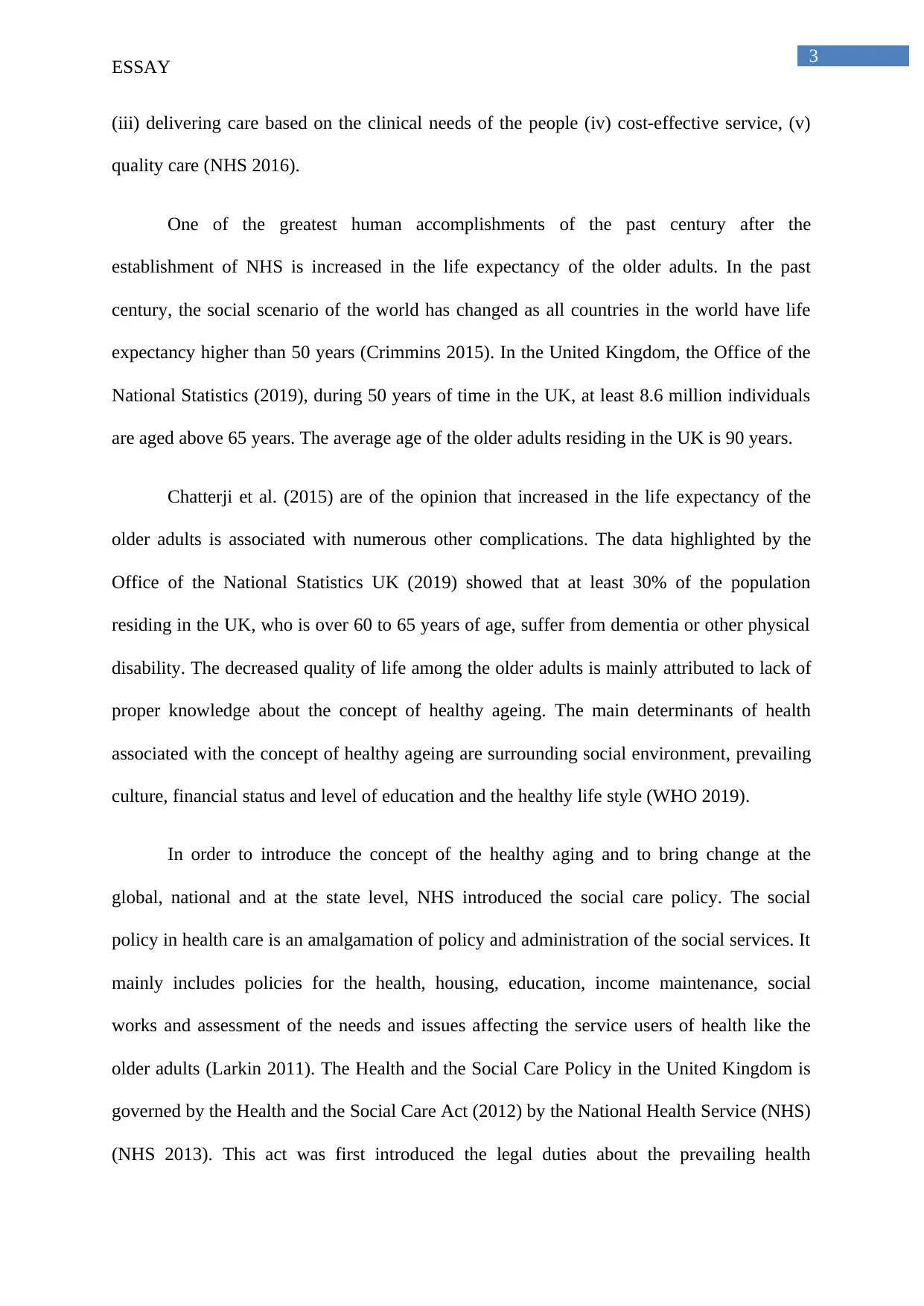
3
ESSAY
(iii) delivering care based on the clinical needs of the people (iv) cost-effective service, (v)
quality care (NHS 2016).
One of the greatest human accomplishments of the past century after the
establishment of NHS is increased in the life expectancy of the older adults. In the past
century, the social scenario of the world has changed as all countries in the world have life
expectancy higher than 50 years (Crimmins 2015). In the United Kingdom, the Office of the
National Statistics (2019), during 50 years of time in the UK, at least 8.6 million individuals
are aged above 65 years. The average age of the older adults residing in the UK is 90 years.
Chatterji et al. (2015) are of the opinion that increased in the life expectancy of the
older adults is associated with numerous other complications. The data highlighted by the
Office of the National Statistics UK (2019) showed that at least 30% of the population
residing in the UK, who is over 60 to 65 years of age, suffer from dementia or other physical
disability. The decreased quality of life among the older adults is mainly attributed to lack of
proper knowledge about the concept of healthy ageing. The main determinants of health
associated with the concept of healthy ageing are surrounding social environment, prevailing
culture, financial status and level of education and the healthy life style (WHO 2019).
In order to introduce the concept of the healthy aging and to bring change at the
global, national and at the state level, NHS introduced the social care policy. The social
policy in health care is an amalgamation of policy and administration of the social services. It
mainly includes policies for the health, housing, education, income maintenance, social
works and assessment of the needs and issues affecting the service users of health like the
older adults (Larkin 2011). The Health and the Social Care Policy in the United Kingdom is
governed by the Health and the Social Care Act (2012) by the National Health Service (NHS)
(NHS 2013). This act was first introduced the legal duties about the prevailing health
ESSAY
(iii) delivering care based on the clinical needs of the people (iv) cost-effective service, (v)
quality care (NHS 2016).
One of the greatest human accomplishments of the past century after the
establishment of NHS is increased in the life expectancy of the older adults. In the past
century, the social scenario of the world has changed as all countries in the world have life
expectancy higher than 50 years (Crimmins 2015). In the United Kingdom, the Office of the
National Statistics (2019), during 50 years of time in the UK, at least 8.6 million individuals
are aged above 65 years. The average age of the older adults residing in the UK is 90 years.
Chatterji et al. (2015) are of the opinion that increased in the life expectancy of the
older adults is associated with numerous other complications. The data highlighted by the
Office of the National Statistics UK (2019) showed that at least 30% of the population
residing in the UK, who is over 60 to 65 years of age, suffer from dementia or other physical
disability. The decreased quality of life among the older adults is mainly attributed to lack of
proper knowledge about the concept of healthy ageing. The main determinants of health
associated with the concept of healthy ageing are surrounding social environment, prevailing
culture, financial status and level of education and the healthy life style (WHO 2019).
In order to introduce the concept of the healthy aging and to bring change at the
global, national and at the state level, NHS introduced the social care policy. The social
policy in health care is an amalgamation of policy and administration of the social services. It
mainly includes policies for the health, housing, education, income maintenance, social
works and assessment of the needs and issues affecting the service users of health like the
older adults (Larkin 2011). The Health and the Social Care Policy in the United Kingdom is
governed by the Health and the Social Care Act (2012) by the National Health Service (NHS)
(NHS 2013). This act was first introduced the legal duties about the prevailing health
Paraphrase This Document
Need a fresh take? Get an instant paraphrase of this document with our AI Paraphraser
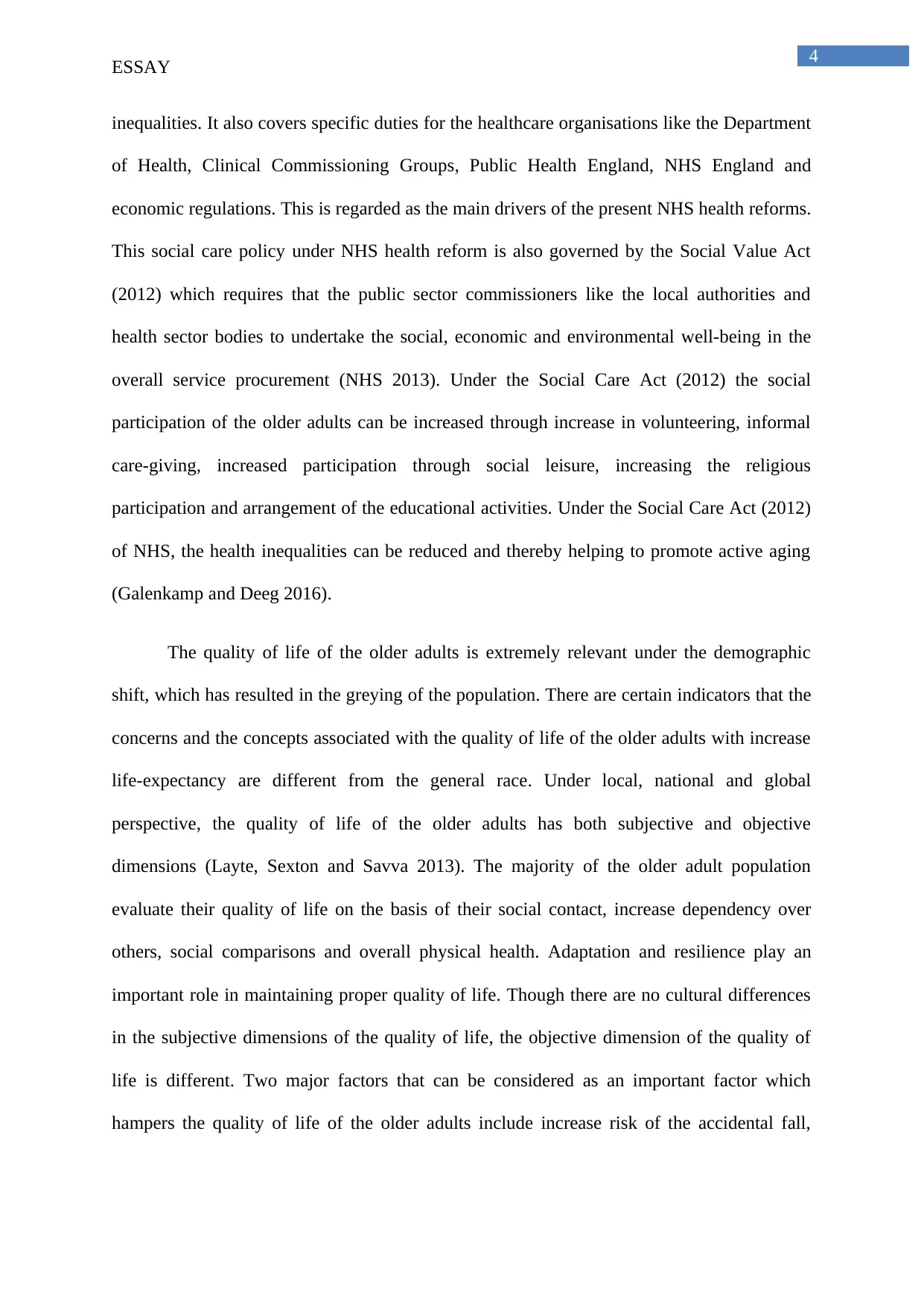
4
ESSAY
inequalities. It also covers specific duties for the healthcare organisations like the Department
of Health, Clinical Commissioning Groups, Public Health England, NHS England and
economic regulations. This is regarded as the main drivers of the present NHS health reforms.
This social care policy under NHS health reform is also governed by the Social Value Act
(2012) which requires that the public sector commissioners like the local authorities and
health sector bodies to undertake the social, economic and environmental well-being in the
overall service procurement (NHS 2013). Under the Social Care Act (2012) the social
participation of the older adults can be increased through increase in volunteering, informal
care-giving, increased participation through social leisure, increasing the religious
participation and arrangement of the educational activities. Under the Social Care Act (2012)
of NHS, the health inequalities can be reduced and thereby helping to promote active aging
(Galenkamp and Deeg 2016).
The quality of life of the older adults is extremely relevant under the demographic
shift, which has resulted in the greying of the population. There are certain indicators that the
concerns and the concepts associated with the quality of life of the older adults with increase
life-expectancy are different from the general race. Under local, national and global
perspective, the quality of life of the older adults has both subjective and objective
dimensions (Layte, Sexton and Savva 2013). The majority of the older adult population
evaluate their quality of life on the basis of their social contact, increase dependency over
others, social comparisons and overall physical health. Adaptation and resilience play an
important role in maintaining proper quality of life. Though there are no cultural differences
in the subjective dimensions of the quality of life, the objective dimension of the quality of
life is different. Two major factors that can be considered as an important factor which
hampers the quality of life of the older adults include increase risk of the accidental fall,
ESSAY
inequalities. It also covers specific duties for the healthcare organisations like the Department
of Health, Clinical Commissioning Groups, Public Health England, NHS England and
economic regulations. This is regarded as the main drivers of the present NHS health reforms.
This social care policy under NHS health reform is also governed by the Social Value Act
(2012) which requires that the public sector commissioners like the local authorities and
health sector bodies to undertake the social, economic and environmental well-being in the
overall service procurement (NHS 2013). Under the Social Care Act (2012) the social
participation of the older adults can be increased through increase in volunteering, informal
care-giving, increased participation through social leisure, increasing the religious
participation and arrangement of the educational activities. Under the Social Care Act (2012)
of NHS, the health inequalities can be reduced and thereby helping to promote active aging
(Galenkamp and Deeg 2016).
The quality of life of the older adults is extremely relevant under the demographic
shift, which has resulted in the greying of the population. There are certain indicators that the
concerns and the concepts associated with the quality of life of the older adults with increase
life-expectancy are different from the general race. Under local, national and global
perspective, the quality of life of the older adults has both subjective and objective
dimensions (Layte, Sexton and Savva 2013). The majority of the older adult population
evaluate their quality of life on the basis of their social contact, increase dependency over
others, social comparisons and overall physical health. Adaptation and resilience play an
important role in maintaining proper quality of life. Though there are no cultural differences
in the subjective dimensions of the quality of life, the objective dimension of the quality of
life is different. Two major factors that can be considered as an important factor which
hampers the quality of life of the older adults include increase risk of the accidental fall,
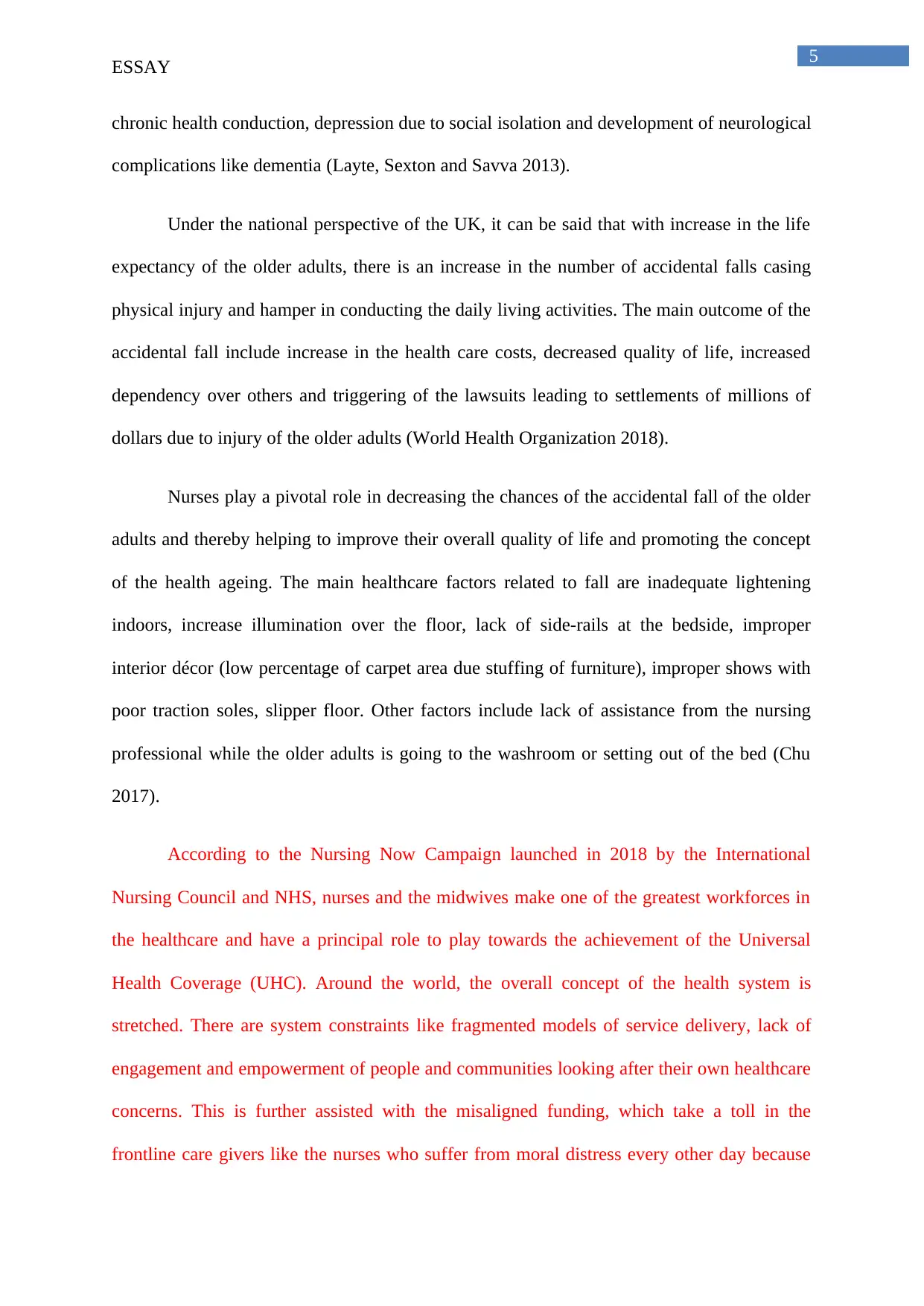
5
ESSAY
chronic health conduction, depression due to social isolation and development of neurological
complications like dementia (Layte, Sexton and Savva 2013).
Under the national perspective of the UK, it can be said that with increase in the life
expectancy of the older adults, there is an increase in the number of accidental falls casing
physical injury and hamper in conducting the daily living activities. The main outcome of the
accidental fall include increase in the health care costs, decreased quality of life, increased
dependency over others and triggering of the lawsuits leading to settlements of millions of
dollars due to injury of the older adults (World Health Organization 2018).
Nurses play a pivotal role in decreasing the chances of the accidental fall of the older
adults and thereby helping to improve their overall quality of life and promoting the concept
of the health ageing. The main healthcare factors related to fall are inadequate lightening
indoors, increase illumination over the floor, lack of side-rails at the bedside, improper
interior décor (low percentage of carpet area due stuffing of furniture), improper shows with
poor traction soles, slipper floor. Other factors include lack of assistance from the nursing
professional while the older adults is going to the washroom or setting out of the bed (Chu
2017).
According to the Nursing Now Campaign launched in 2018 by the International
Nursing Council and NHS, nurses and the midwives make one of the greatest workforces in
the healthcare and have a principal role to play towards the achievement of the Universal
Health Coverage (UHC). Around the world, the overall concept of the health system is
stretched. There are system constraints like fragmented models of service delivery, lack of
engagement and empowerment of people and communities looking after their own healthcare
concerns. This is further assisted with the misaligned funding, which take a toll in the
frontline care givers like the nurses who suffer from moral distress every other day because
ESSAY
chronic health conduction, depression due to social isolation and development of neurological
complications like dementia (Layte, Sexton and Savva 2013).
Under the national perspective of the UK, it can be said that with increase in the life
expectancy of the older adults, there is an increase in the number of accidental falls casing
physical injury and hamper in conducting the daily living activities. The main outcome of the
accidental fall include increase in the health care costs, decreased quality of life, increased
dependency over others and triggering of the lawsuits leading to settlements of millions of
dollars due to injury of the older adults (World Health Organization 2018).
Nurses play a pivotal role in decreasing the chances of the accidental fall of the older
adults and thereby helping to improve their overall quality of life and promoting the concept
of the health ageing. The main healthcare factors related to fall are inadequate lightening
indoors, increase illumination over the floor, lack of side-rails at the bedside, improper
interior décor (low percentage of carpet area due stuffing of furniture), improper shows with
poor traction soles, slipper floor. Other factors include lack of assistance from the nursing
professional while the older adults is going to the washroom or setting out of the bed (Chu
2017).
According to the Nursing Now Campaign launched in 2018 by the International
Nursing Council and NHS, nurses and the midwives make one of the greatest workforces in
the healthcare and have a principal role to play towards the achievement of the Universal
Health Coverage (UHC). Around the world, the overall concept of the health system is
stretched. There are system constraints like fragmented models of service delivery, lack of
engagement and empowerment of people and communities looking after their own healthcare
concerns. This is further assisted with the misaligned funding, which take a toll in the
frontline care givers like the nurses who suffer from moral distress every other day because
⊘ This is a preview!⊘
Do you want full access?
Subscribe today to unlock all pages.

Trusted by 1+ million students worldwide
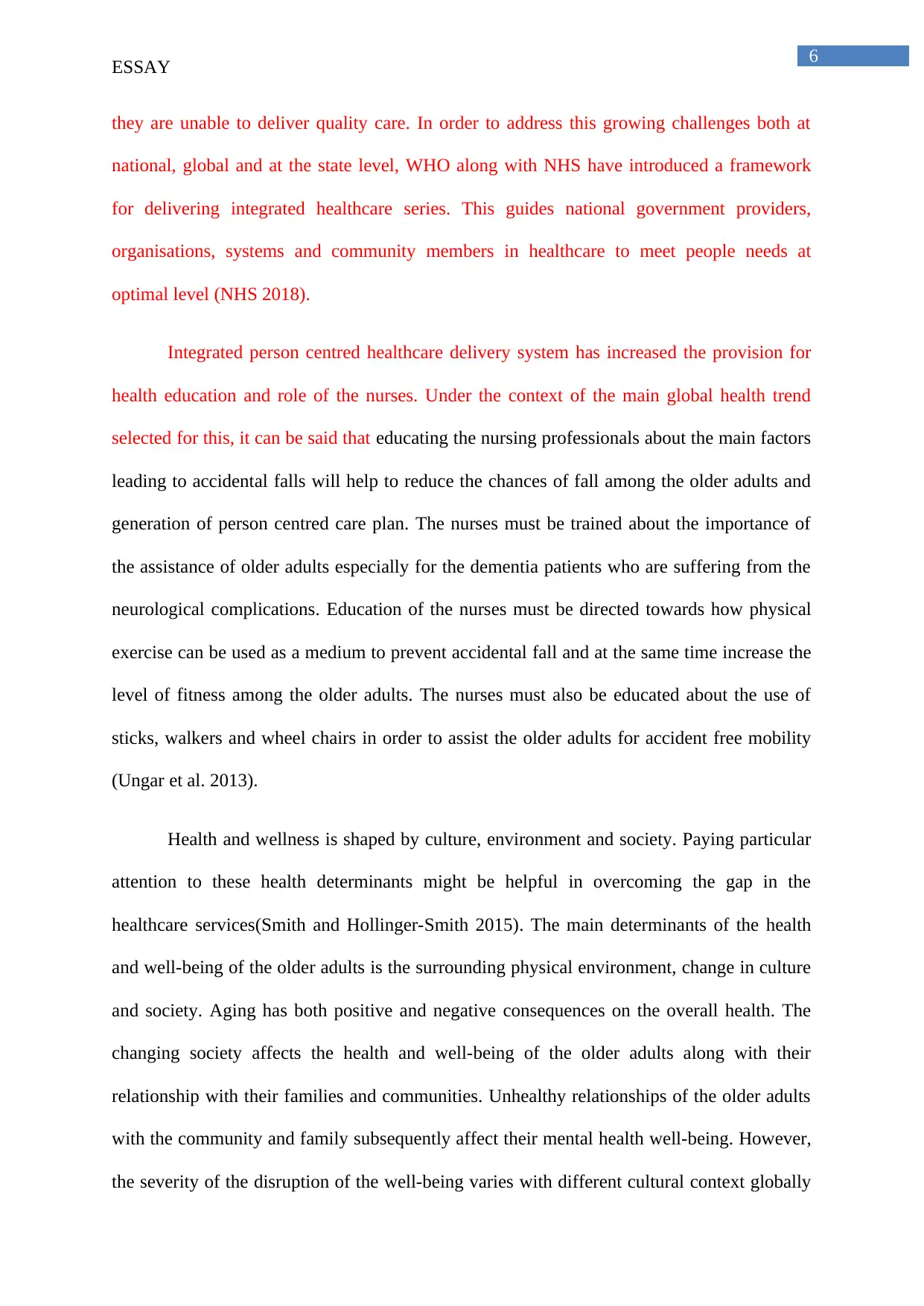
6
ESSAY
they are unable to deliver quality care. In order to address this growing challenges both at
national, global and at the state level, WHO along with NHS have introduced a framework
for delivering integrated healthcare series. This guides national government providers,
organisations, systems and community members in healthcare to meet people needs at
optimal level (NHS 2018).
Integrated person centred healthcare delivery system has increased the provision for
health education and role of the nurses. Under the context of the main global health trend
selected for this, it can be said that educating the nursing professionals about the main factors
leading to accidental falls will help to reduce the chances of fall among the older adults and
generation of person centred care plan. The nurses must be trained about the importance of
the assistance of older adults especially for the dementia patients who are suffering from the
neurological complications. Education of the nurses must be directed towards how physical
exercise can be used as a medium to prevent accidental fall and at the same time increase the
level of fitness among the older adults. The nurses must also be educated about the use of
sticks, walkers and wheel chairs in order to assist the older adults for accident free mobility
(Ungar et al. 2013).
Health and wellness is shaped by culture, environment and society. Paying particular
attention to these health determinants might be helpful in overcoming the gap in the
healthcare services(Smith and Hollinger-Smith 2015). The main determinants of the health
and well-being of the older adults is the surrounding physical environment, change in culture
and society. Aging has both positive and negative consequences on the overall health. The
changing society affects the health and well-being of the older adults along with their
relationship with their families and communities. Unhealthy relationships of the older adults
with the community and family subsequently affect their mental health well-being. However,
the severity of the disruption of the well-being varies with different cultural context globally
ESSAY
they are unable to deliver quality care. In order to address this growing challenges both at
national, global and at the state level, WHO along with NHS have introduced a framework
for delivering integrated healthcare series. This guides national government providers,
organisations, systems and community members in healthcare to meet people needs at
optimal level (NHS 2018).
Integrated person centred healthcare delivery system has increased the provision for
health education and role of the nurses. Under the context of the main global health trend
selected for this, it can be said that educating the nursing professionals about the main factors
leading to accidental falls will help to reduce the chances of fall among the older adults and
generation of person centred care plan. The nurses must be trained about the importance of
the assistance of older adults especially for the dementia patients who are suffering from the
neurological complications. Education of the nurses must be directed towards how physical
exercise can be used as a medium to prevent accidental fall and at the same time increase the
level of fitness among the older adults. The nurses must also be educated about the use of
sticks, walkers and wheel chairs in order to assist the older adults for accident free mobility
(Ungar et al. 2013).
Health and wellness is shaped by culture, environment and society. Paying particular
attention to these health determinants might be helpful in overcoming the gap in the
healthcare services(Smith and Hollinger-Smith 2015). The main determinants of the health
and well-being of the older adults is the surrounding physical environment, change in culture
and society. Aging has both positive and negative consequences on the overall health. The
changing society affects the health and well-being of the older adults along with their
relationship with their families and communities. Unhealthy relationships of the older adults
with the community and family subsequently affect their mental health well-being. However,
the severity of the disruption of the well-being varies with different cultural context globally
Paraphrase This Document
Need a fresh take? Get an instant paraphrase of this document with our AI Paraphraser
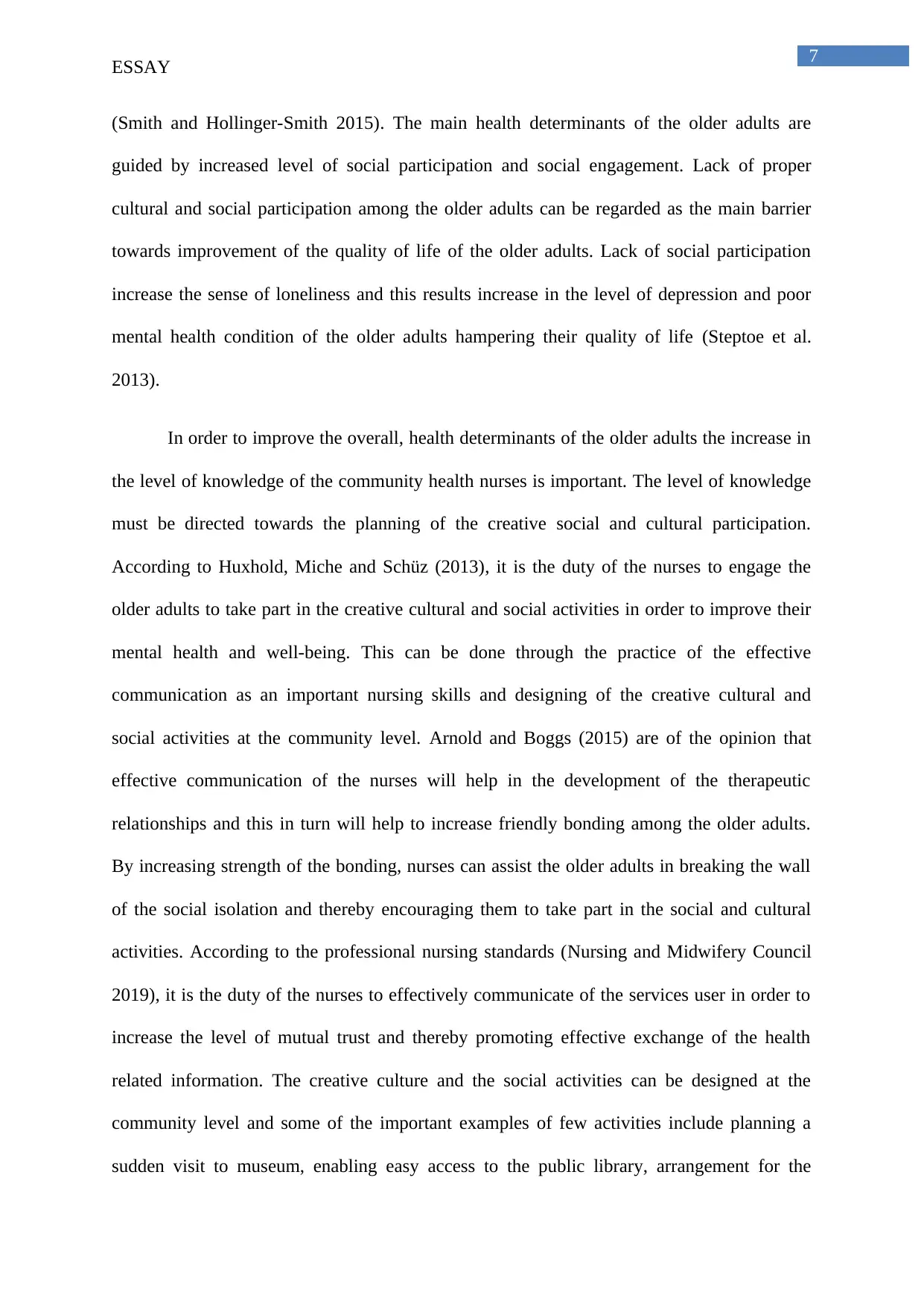
7
ESSAY
(Smith and Hollinger-Smith 2015). The main health determinants of the older adults are
guided by increased level of social participation and social engagement. Lack of proper
cultural and social participation among the older adults can be regarded as the main barrier
towards improvement of the quality of life of the older adults. Lack of social participation
increase the sense of loneliness and this results increase in the level of depression and poor
mental health condition of the older adults hampering their quality of life (Steptoe et al.
2013).
In order to improve the overall, health determinants of the older adults the increase in
the level of knowledge of the community health nurses is important. The level of knowledge
must be directed towards the planning of the creative social and cultural participation.
According to Huxhold, Miche and Schüz (2013), it is the duty of the nurses to engage the
older adults to take part in the creative cultural and social activities in order to improve their
mental health and well-being. This can be done through the practice of the effective
communication as an important nursing skills and designing of the creative cultural and
social activities at the community level. Arnold and Boggs (2015) are of the opinion that
effective communication of the nurses will help in the development of the therapeutic
relationships and this in turn will help to increase friendly bonding among the older adults.
By increasing strength of the bonding, nurses can assist the older adults in breaking the wall
of the social isolation and thereby encouraging them to take part in the social and cultural
activities. According to the professional nursing standards (Nursing and Midwifery Council
2019), it is the duty of the nurses to effectively communicate of the services user in order to
increase the level of mutual trust and thereby promoting effective exchange of the health
related information. The creative culture and the social activities can be designed at the
community level and some of the important examples of few activities include planning a
sudden visit to museum, enabling easy access to the public library, arrangement for the
ESSAY
(Smith and Hollinger-Smith 2015). The main health determinants of the older adults are
guided by increased level of social participation and social engagement. Lack of proper
cultural and social participation among the older adults can be regarded as the main barrier
towards improvement of the quality of life of the older adults. Lack of social participation
increase the sense of loneliness and this results increase in the level of depression and poor
mental health condition of the older adults hampering their quality of life (Steptoe et al.
2013).
In order to improve the overall, health determinants of the older adults the increase in
the level of knowledge of the community health nurses is important. The level of knowledge
must be directed towards the planning of the creative social and cultural participation.
According to Huxhold, Miche and Schüz (2013), it is the duty of the nurses to engage the
older adults to take part in the creative cultural and social activities in order to improve their
mental health and well-being. This can be done through the practice of the effective
communication as an important nursing skills and designing of the creative cultural and
social activities at the community level. Arnold and Boggs (2015) are of the opinion that
effective communication of the nurses will help in the development of the therapeutic
relationships and this in turn will help to increase friendly bonding among the older adults.
By increasing strength of the bonding, nurses can assist the older adults in breaking the wall
of the social isolation and thereby encouraging them to take part in the social and cultural
activities. According to the professional nursing standards (Nursing and Midwifery Council
2019), it is the duty of the nurses to effectively communicate of the services user in order to
increase the level of mutual trust and thereby promoting effective exchange of the health
related information. The creative culture and the social activities can be designed at the
community level and some of the important examples of few activities include planning a
sudden visit to museum, enabling easy access to the public library, arrangement for the
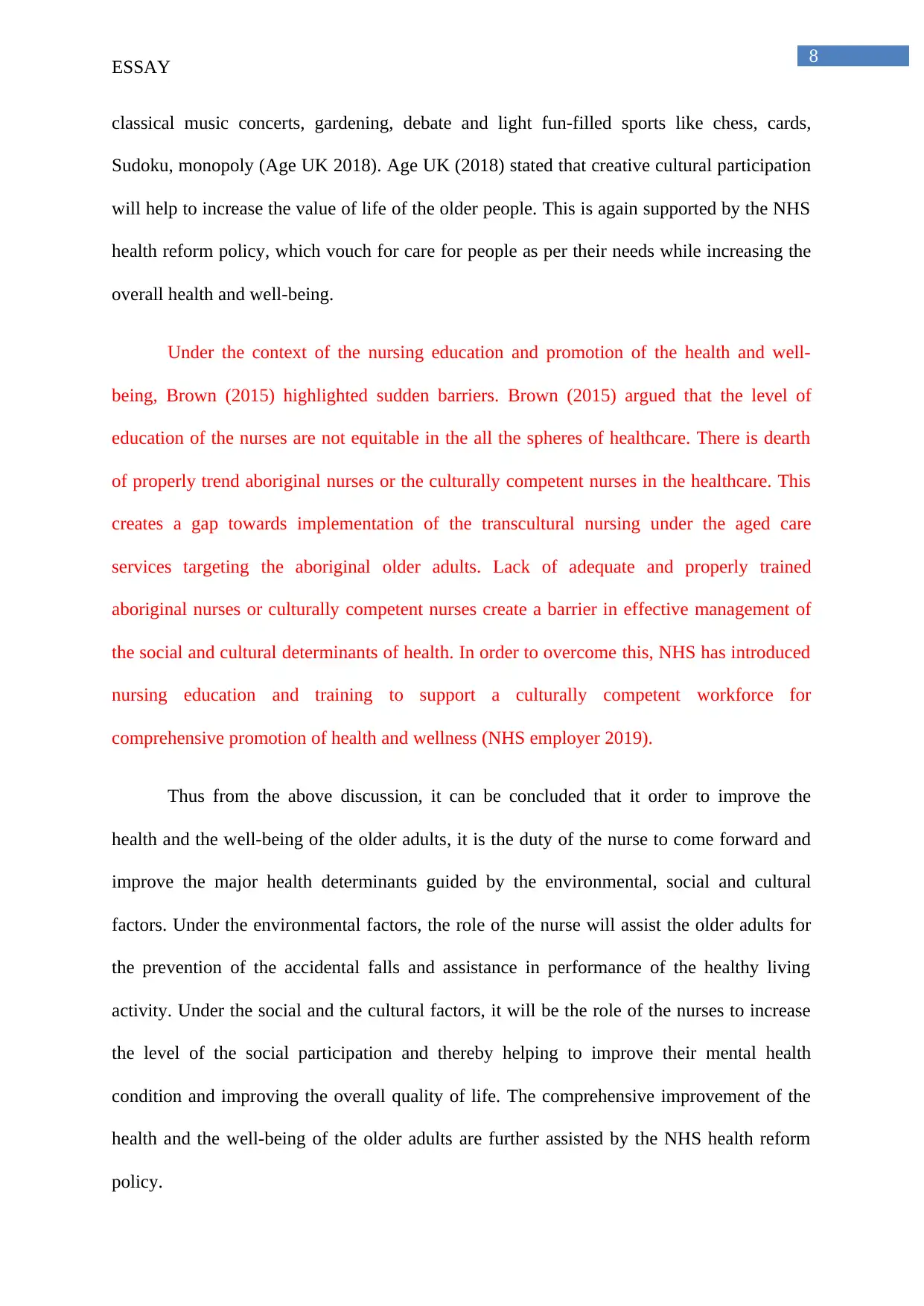
8
ESSAY
classical music concerts, gardening, debate and light fun-filled sports like chess, cards,
Sudoku, monopoly (Age UK 2018). Age UK (2018) stated that creative cultural participation
will help to increase the value of life of the older people. This is again supported by the NHS
health reform policy, which vouch for care for people as per their needs while increasing the
overall health and well-being.
Under the context of the nursing education and promotion of the health and well-
being, Brown (2015) highlighted sudden barriers. Brown (2015) argued that the level of
education of the nurses are not equitable in the all the spheres of healthcare. There is dearth
of properly trend aboriginal nurses or the culturally competent nurses in the healthcare. This
creates a gap towards implementation of the transcultural nursing under the aged care
services targeting the aboriginal older adults. Lack of adequate and properly trained
aboriginal nurses or culturally competent nurses create a barrier in effective management of
the social and cultural determinants of health. In order to overcome this, NHS has introduced
nursing education and training to support a culturally competent workforce for
comprehensive promotion of health and wellness (NHS employer 2019).
Thus from the above discussion, it can be concluded that it order to improve the
health and the well-being of the older adults, it is the duty of the nurse to come forward and
improve the major health determinants guided by the environmental, social and cultural
factors. Under the environmental factors, the role of the nurse will assist the older adults for
the prevention of the accidental falls and assistance in performance of the healthy living
activity. Under the social and the cultural factors, it will be the role of the nurses to increase
the level of the social participation and thereby helping to improve their mental health
condition and improving the overall quality of life. The comprehensive improvement of the
health and the well-being of the older adults are further assisted by the NHS health reform
policy.
ESSAY
classical music concerts, gardening, debate and light fun-filled sports like chess, cards,
Sudoku, monopoly (Age UK 2018). Age UK (2018) stated that creative cultural participation
will help to increase the value of life of the older people. This is again supported by the NHS
health reform policy, which vouch for care for people as per their needs while increasing the
overall health and well-being.
Under the context of the nursing education and promotion of the health and well-
being, Brown (2015) highlighted sudden barriers. Brown (2015) argued that the level of
education of the nurses are not equitable in the all the spheres of healthcare. There is dearth
of properly trend aboriginal nurses or the culturally competent nurses in the healthcare. This
creates a gap towards implementation of the transcultural nursing under the aged care
services targeting the aboriginal older adults. Lack of adequate and properly trained
aboriginal nurses or culturally competent nurses create a barrier in effective management of
the social and cultural determinants of health. In order to overcome this, NHS has introduced
nursing education and training to support a culturally competent workforce for
comprehensive promotion of health and wellness (NHS employer 2019).
Thus from the above discussion, it can be concluded that it order to improve the
health and the well-being of the older adults, it is the duty of the nurse to come forward and
improve the major health determinants guided by the environmental, social and cultural
factors. Under the environmental factors, the role of the nurse will assist the older adults for
the prevention of the accidental falls and assistance in performance of the healthy living
activity. Under the social and the cultural factors, it will be the role of the nurses to increase
the level of the social participation and thereby helping to improve their mental health
condition and improving the overall quality of life. The comprehensive improvement of the
health and the well-being of the older adults are further assisted by the NHS health reform
policy.
⊘ This is a preview!⊘
Do you want full access?
Subscribe today to unlock all pages.

Trusted by 1+ million students worldwide
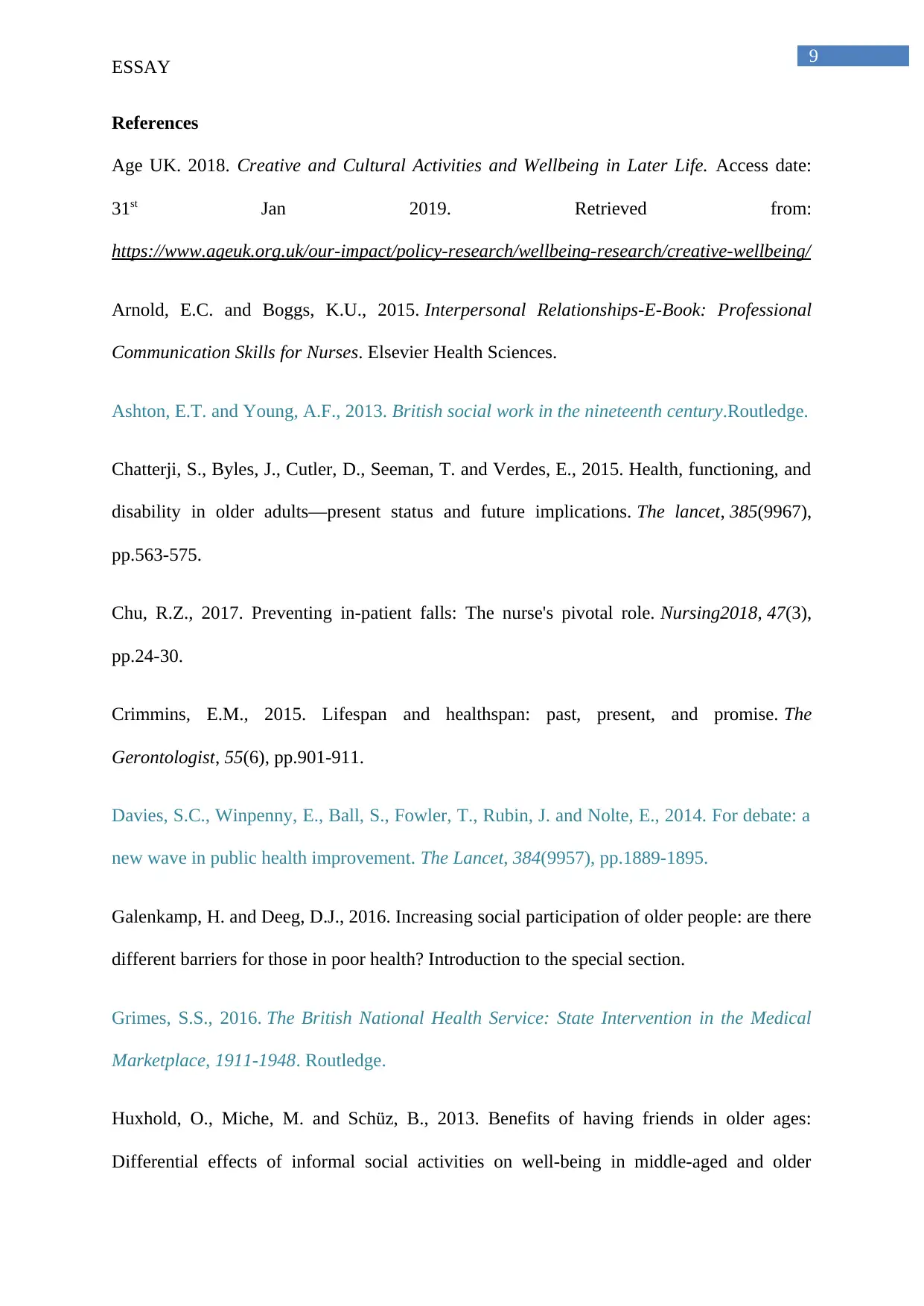
9
ESSAY
References
Age UK. 2018. Creative and Cultural Activities and Wellbeing in Later Life. Access date:
31st Jan 2019. Retrieved from:
https://www.ageuk.org.uk/our-impact/policy-research/wellbeing-research/creative-wellbeing/
Arnold, E.C. and Boggs, K.U., 2015. Interpersonal Relationships-E-Book: Professional
Communication Skills for Nurses. Elsevier Health Sciences.
Ashton, E.T. and Young, A.F., 2013. British social work in the nineteenth century.Routledge.
Chatterji, S., Byles, J., Cutler, D., Seeman, T. and Verdes, E., 2015. Health, functioning, and
disability in older adults—present status and future implications. The lancet, 385(9967),
pp.563-575.
Chu, R.Z., 2017. Preventing in-patient falls: The nurse's pivotal role. Nursing2018, 47(3),
pp.24-30.
Crimmins, E.M., 2015. Lifespan and healthspan: past, present, and promise. The
Gerontologist, 55(6), pp.901-911.
Davies, S.C., Winpenny, E., Ball, S., Fowler, T., Rubin, J. and Nolte, E., 2014. For debate: a
new wave in public health improvement. The Lancet, 384(9957), pp.1889-1895.
Galenkamp, H. and Deeg, D.J., 2016. Increasing social participation of older people: are there
different barriers for those in poor health? Introduction to the special section.
Grimes, S.S., 2016. The British National Health Service: State Intervention in the Medical
Marketplace, 1911-1948. Routledge.
Huxhold, O., Miche, M. and Schüz, B., 2013. Benefits of having friends in older ages:
Differential effects of informal social activities on well-being in middle-aged and older
ESSAY
References
Age UK. 2018. Creative and Cultural Activities and Wellbeing in Later Life. Access date:
31st Jan 2019. Retrieved from:
https://www.ageuk.org.uk/our-impact/policy-research/wellbeing-research/creative-wellbeing/
Arnold, E.C. and Boggs, K.U., 2015. Interpersonal Relationships-E-Book: Professional
Communication Skills for Nurses. Elsevier Health Sciences.
Ashton, E.T. and Young, A.F., 2013. British social work in the nineteenth century.Routledge.
Chatterji, S., Byles, J., Cutler, D., Seeman, T. and Verdes, E., 2015. Health, functioning, and
disability in older adults—present status and future implications. The lancet, 385(9967),
pp.563-575.
Chu, R.Z., 2017. Preventing in-patient falls: The nurse's pivotal role. Nursing2018, 47(3),
pp.24-30.
Crimmins, E.M., 2015. Lifespan and healthspan: past, present, and promise. The
Gerontologist, 55(6), pp.901-911.
Davies, S.C., Winpenny, E., Ball, S., Fowler, T., Rubin, J. and Nolte, E., 2014. For debate: a
new wave in public health improvement. The Lancet, 384(9957), pp.1889-1895.
Galenkamp, H. and Deeg, D.J., 2016. Increasing social participation of older people: are there
different barriers for those in poor health? Introduction to the special section.
Grimes, S.S., 2016. The British National Health Service: State Intervention in the Medical
Marketplace, 1911-1948. Routledge.
Huxhold, O., Miche, M. and Schüz, B., 2013. Benefits of having friends in older ages:
Differential effects of informal social activities on well-being in middle-aged and older
Paraphrase This Document
Need a fresh take? Get an instant paraphrase of this document with our AI Paraphraser
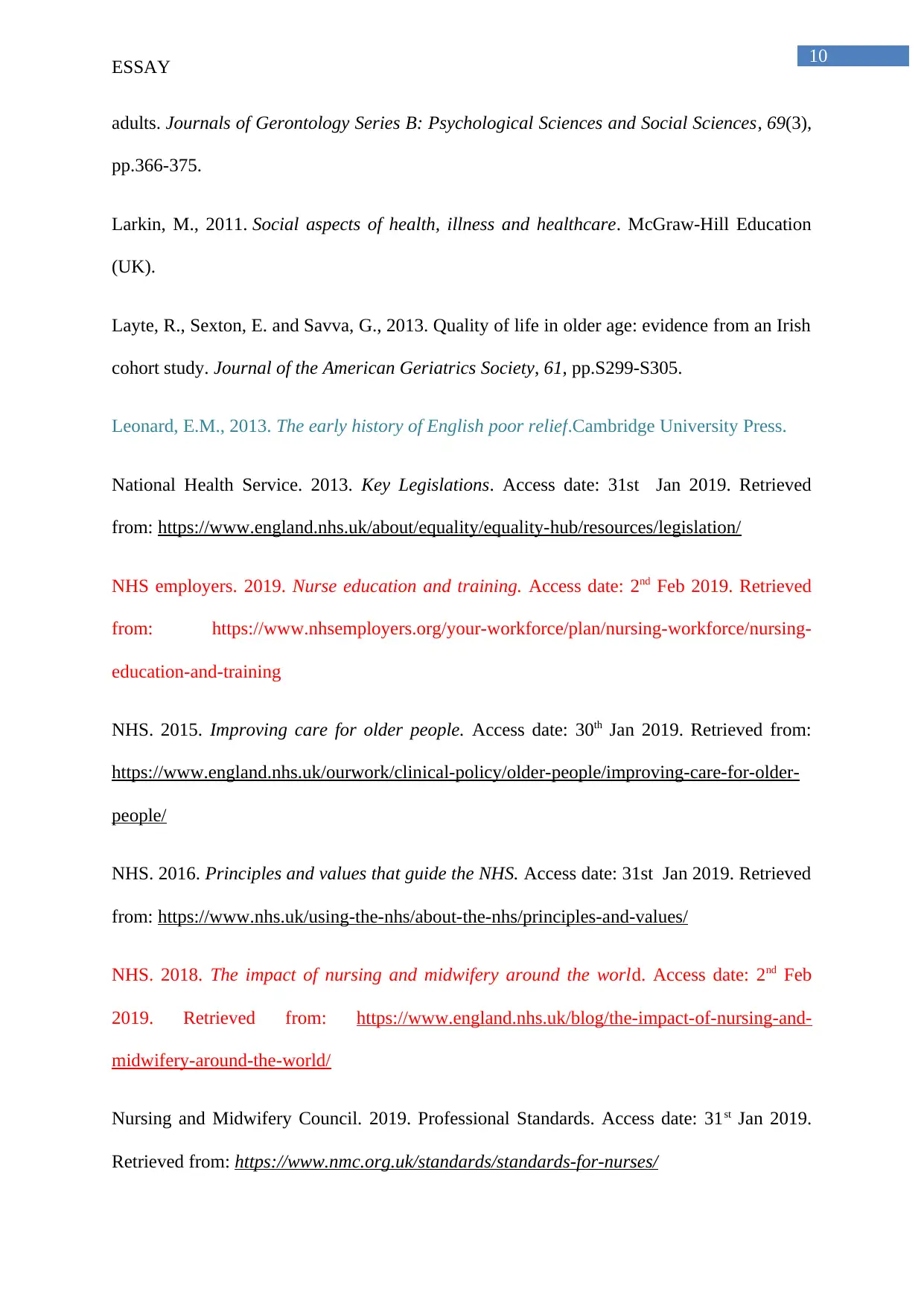
10
ESSAY
adults. Journals of Gerontology Series B: Psychological Sciences and Social Sciences, 69(3),
pp.366-375.
Larkin, M., 2011. Social aspects of health, illness and healthcare. McGraw-Hill Education
(UK).
Layte, R., Sexton, E. and Savva, G., 2013. Quality of life in older age: evidence from an Irish
cohort study. Journal of the American Geriatrics Society, 61, pp.S299-S305.
Leonard, E.M., 2013. The early history of English poor relief.Cambridge University Press.
National Health Service. 2013. Key Legislations. Access date: 31st Jan 2019. Retrieved
from: https://www.england.nhs.uk/about/equality/equality-hub/resources/legislation/
NHS employers. 2019. Nurse education and training. Access date: 2nd Feb 2019. Retrieved
from: https://www.nhsemployers.org/your-workforce/plan/nursing-workforce/nursing-
education-and-training
NHS. 2015. Improving care for older people. Access date: 30th Jan 2019. Retrieved from:
https://www.england.nhs.uk/ourwork/clinical-policy/older-people/improving-care-for-older-
people/
NHS. 2016. Principles and values that guide the NHS. Access date: 31st Jan 2019. Retrieved
from: https://www.nhs.uk/using-the-nhs/about-the-nhs/principles-and-values/
NHS. 2018. The impact of nursing and midwifery around the world. Access date: 2nd Feb
2019. Retrieved from: https://www.england.nhs.uk/blog/the-impact-of-nursing-and-
midwifery-around-the-world/
Nursing and Midwifery Council. 2019. Professional Standards. Access date: 31st Jan 2019.
Retrieved from: https://www.nmc.org.uk/standards/standards-for-nurses/
ESSAY
adults. Journals of Gerontology Series B: Psychological Sciences and Social Sciences, 69(3),
pp.366-375.
Larkin, M., 2011. Social aspects of health, illness and healthcare. McGraw-Hill Education
(UK).
Layte, R., Sexton, E. and Savva, G., 2013. Quality of life in older age: evidence from an Irish
cohort study. Journal of the American Geriatrics Society, 61, pp.S299-S305.
Leonard, E.M., 2013. The early history of English poor relief.Cambridge University Press.
National Health Service. 2013. Key Legislations. Access date: 31st Jan 2019. Retrieved
from: https://www.england.nhs.uk/about/equality/equality-hub/resources/legislation/
NHS employers. 2019. Nurse education and training. Access date: 2nd Feb 2019. Retrieved
from: https://www.nhsemployers.org/your-workforce/plan/nursing-workforce/nursing-
education-and-training
NHS. 2015. Improving care for older people. Access date: 30th Jan 2019. Retrieved from:
https://www.england.nhs.uk/ourwork/clinical-policy/older-people/improving-care-for-older-
people/
NHS. 2016. Principles and values that guide the NHS. Access date: 31st Jan 2019. Retrieved
from: https://www.nhs.uk/using-the-nhs/about-the-nhs/principles-and-values/
NHS. 2018. The impact of nursing and midwifery around the world. Access date: 2nd Feb
2019. Retrieved from: https://www.england.nhs.uk/blog/the-impact-of-nursing-and-
midwifery-around-the-world/
Nursing and Midwifery Council. 2019. Professional Standards. Access date: 31st Jan 2019.
Retrieved from: https://www.nmc.org.uk/standards/standards-for-nurses/
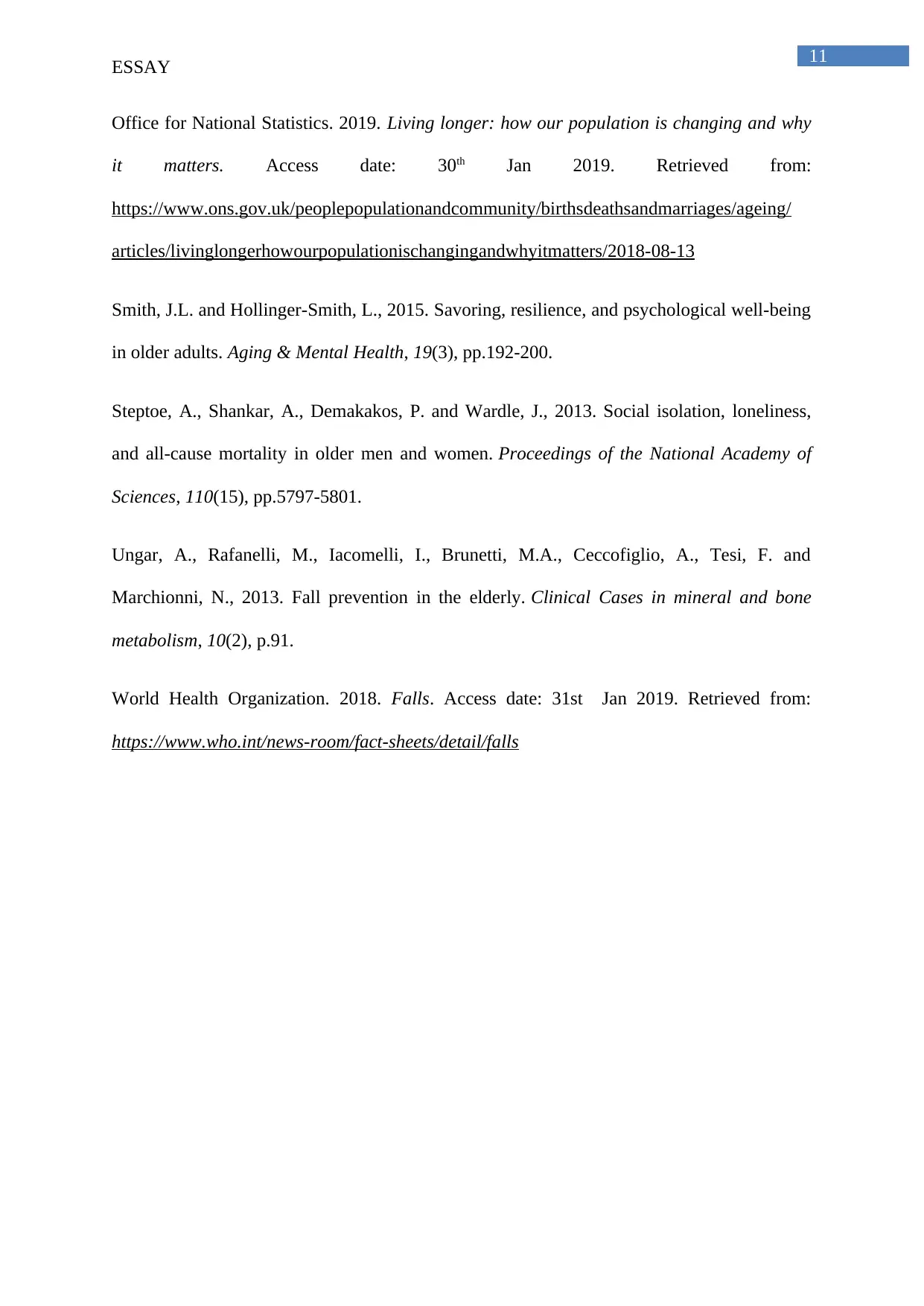
11
ESSAY
Office for National Statistics. 2019. Living longer: how our population is changing and why
it matters. Access date: 30th Jan 2019. Retrieved from:
https://www.ons.gov.uk/peoplepopulationandcommunity/birthsdeathsandmarriages/ageing/
articles/livinglongerhowourpopulationischangingandwhyitmatters/2018-08-13
Smith, J.L. and Hollinger-Smith, L., 2015. Savoring, resilience, and psychological well-being
in older adults. Aging & Mental Health, 19(3), pp.192-200.
Steptoe, A., Shankar, A., Demakakos, P. and Wardle, J., 2013. Social isolation, loneliness,
and all-cause mortality in older men and women. Proceedings of the National Academy of
Sciences, 110(15), pp.5797-5801.
Ungar, A., Rafanelli, M., Iacomelli, I., Brunetti, M.A., Ceccofiglio, A., Tesi, F. and
Marchionni, N., 2013. Fall prevention in the elderly. Clinical Cases in mineral and bone
metabolism, 10(2), p.91.
World Health Organization. 2018. Falls. Access date: 31st Jan 2019. Retrieved from:
https://www.who.int/news-room/fact-sheets/detail/falls
ESSAY
Office for National Statistics. 2019. Living longer: how our population is changing and why
it matters. Access date: 30th Jan 2019. Retrieved from:
https://www.ons.gov.uk/peoplepopulationandcommunity/birthsdeathsandmarriages/ageing/
articles/livinglongerhowourpopulationischangingandwhyitmatters/2018-08-13
Smith, J.L. and Hollinger-Smith, L., 2015. Savoring, resilience, and psychological well-being
in older adults. Aging & Mental Health, 19(3), pp.192-200.
Steptoe, A., Shankar, A., Demakakos, P. and Wardle, J., 2013. Social isolation, loneliness,
and all-cause mortality in older men and women. Proceedings of the National Academy of
Sciences, 110(15), pp.5797-5801.
Ungar, A., Rafanelli, M., Iacomelli, I., Brunetti, M.A., Ceccofiglio, A., Tesi, F. and
Marchionni, N., 2013. Fall prevention in the elderly. Clinical Cases in mineral and bone
metabolism, 10(2), p.91.
World Health Organization. 2018. Falls. Access date: 31st Jan 2019. Retrieved from:
https://www.who.int/news-room/fact-sheets/detail/falls
⊘ This is a preview!⊘
Do you want full access?
Subscribe today to unlock all pages.

Trusted by 1+ million students worldwide
1 out of 12
Related Documents
Your All-in-One AI-Powered Toolkit for Academic Success.
+13062052269
info@desklib.com
Available 24*7 on WhatsApp / Email
![[object Object]](/_next/static/media/star-bottom.7253800d.svg)
Unlock your academic potential
Copyright © 2020–2025 A2Z Services. All Rights Reserved. Developed and managed by ZUCOL.




